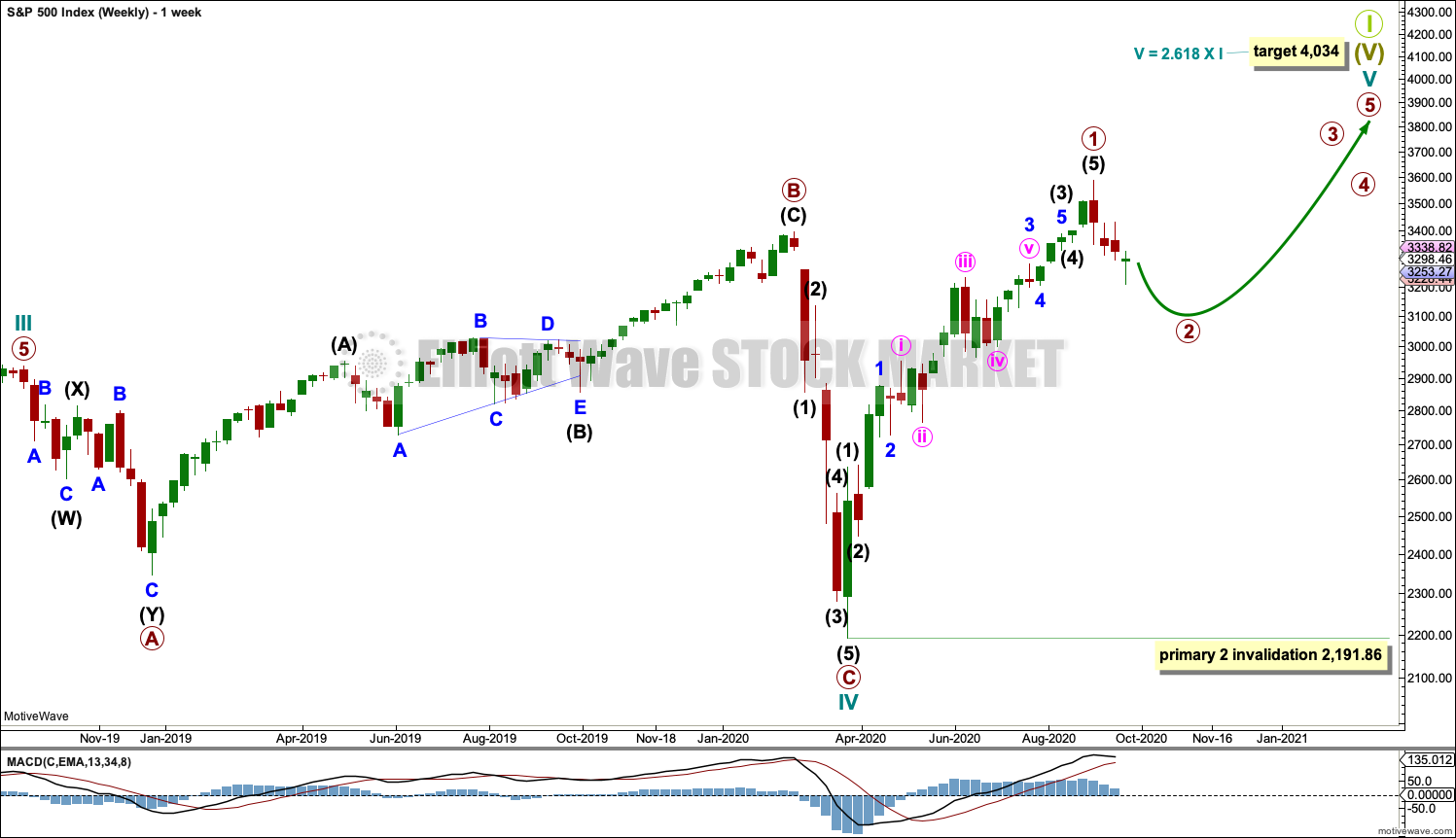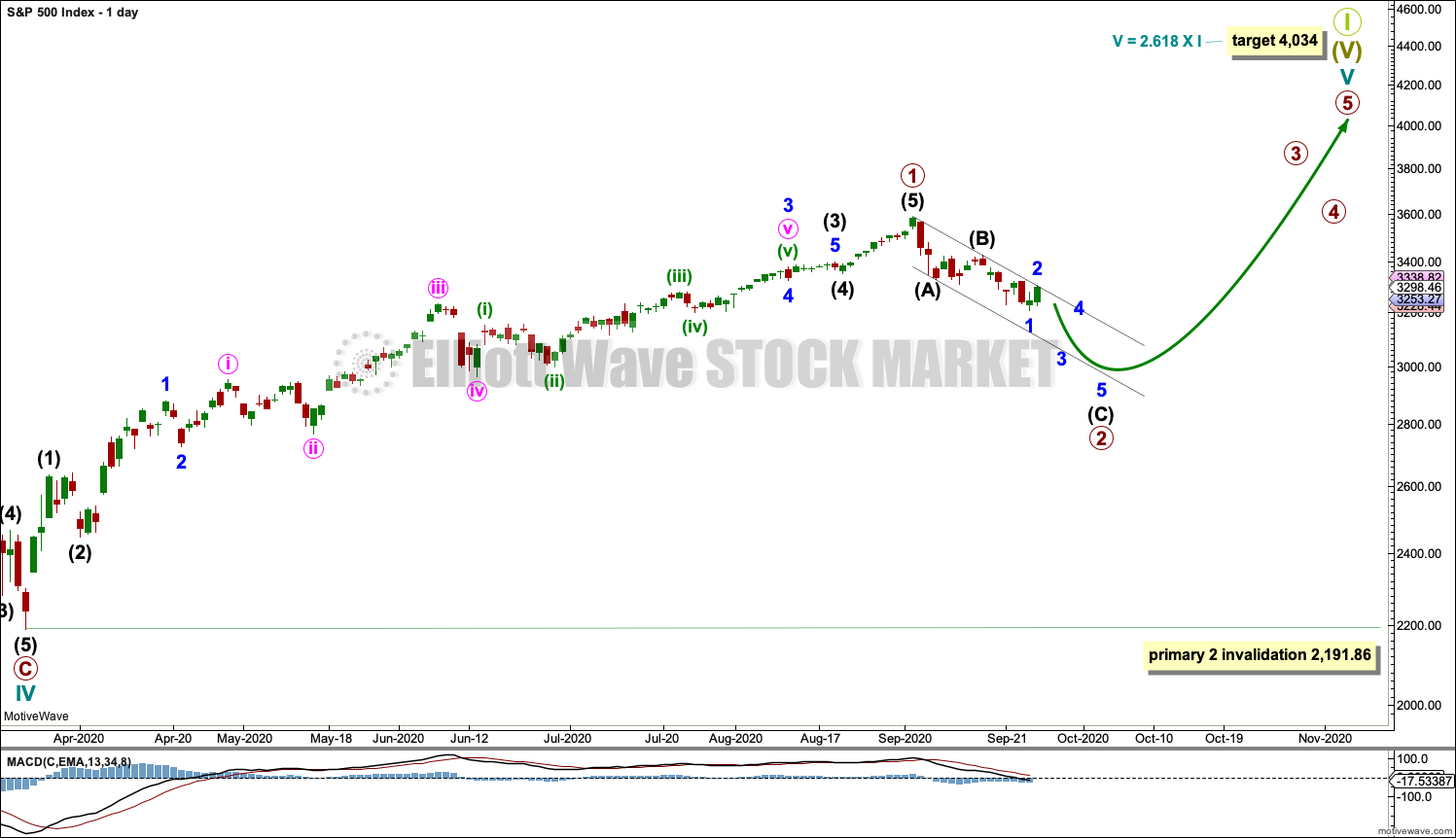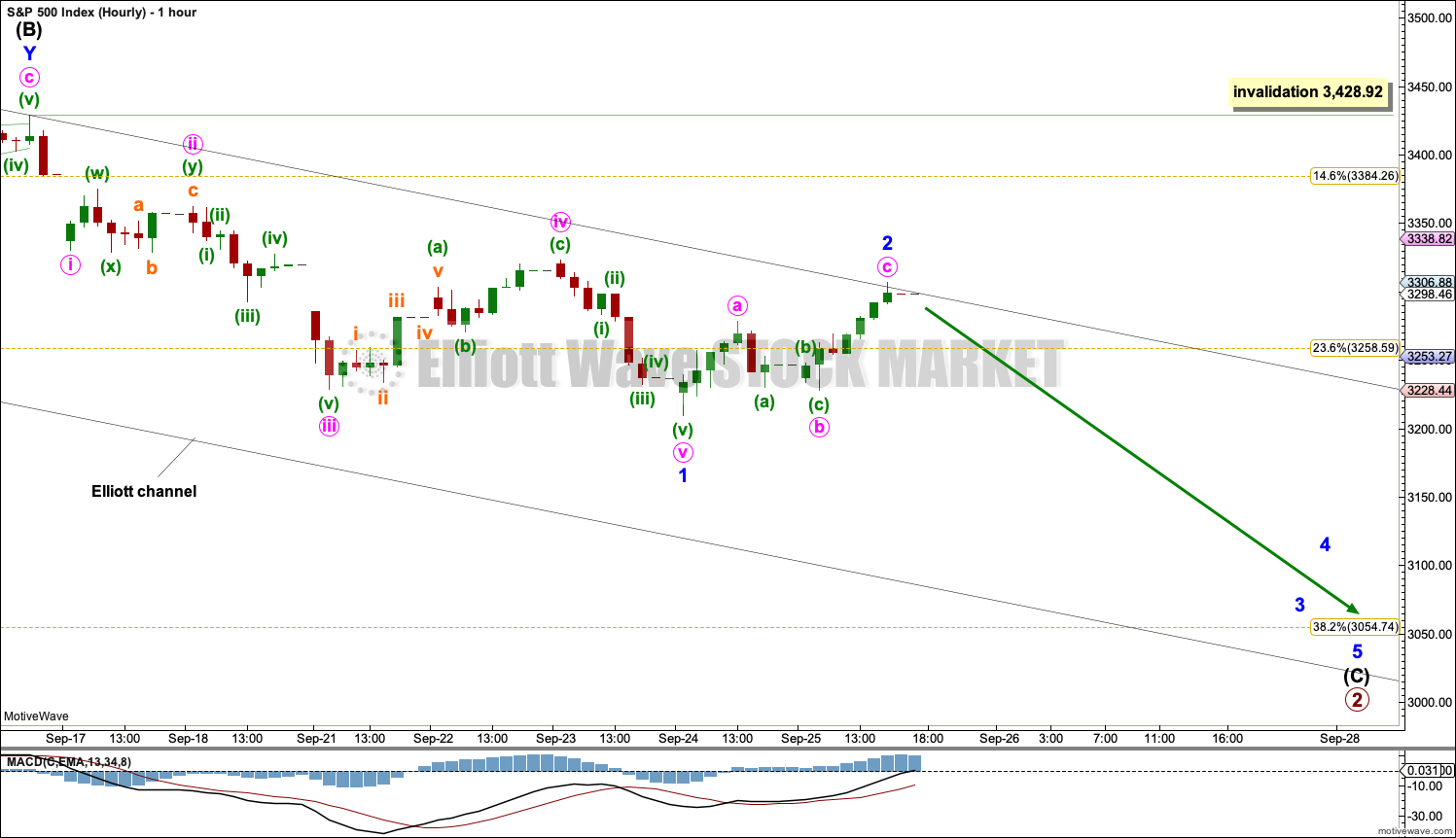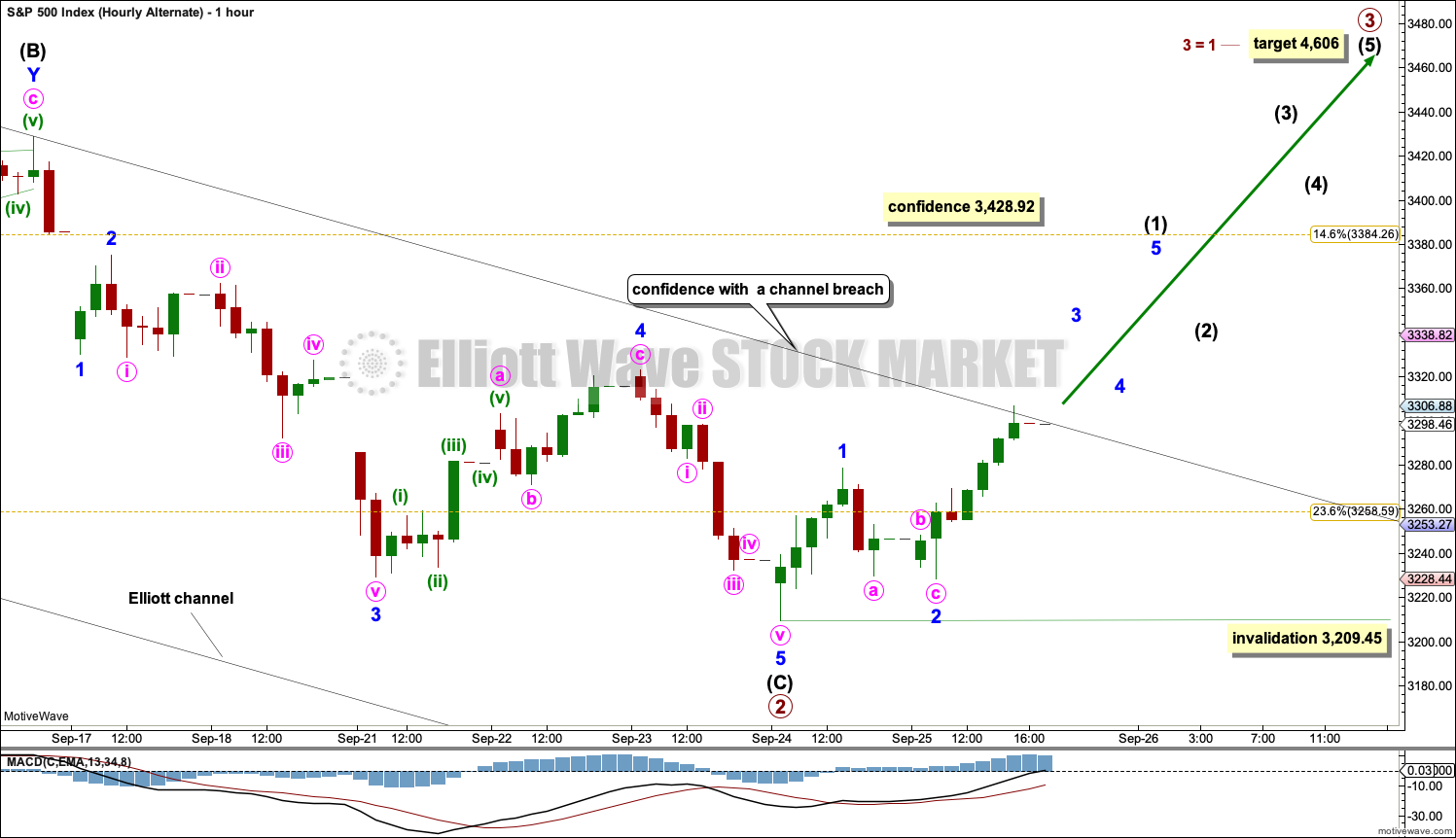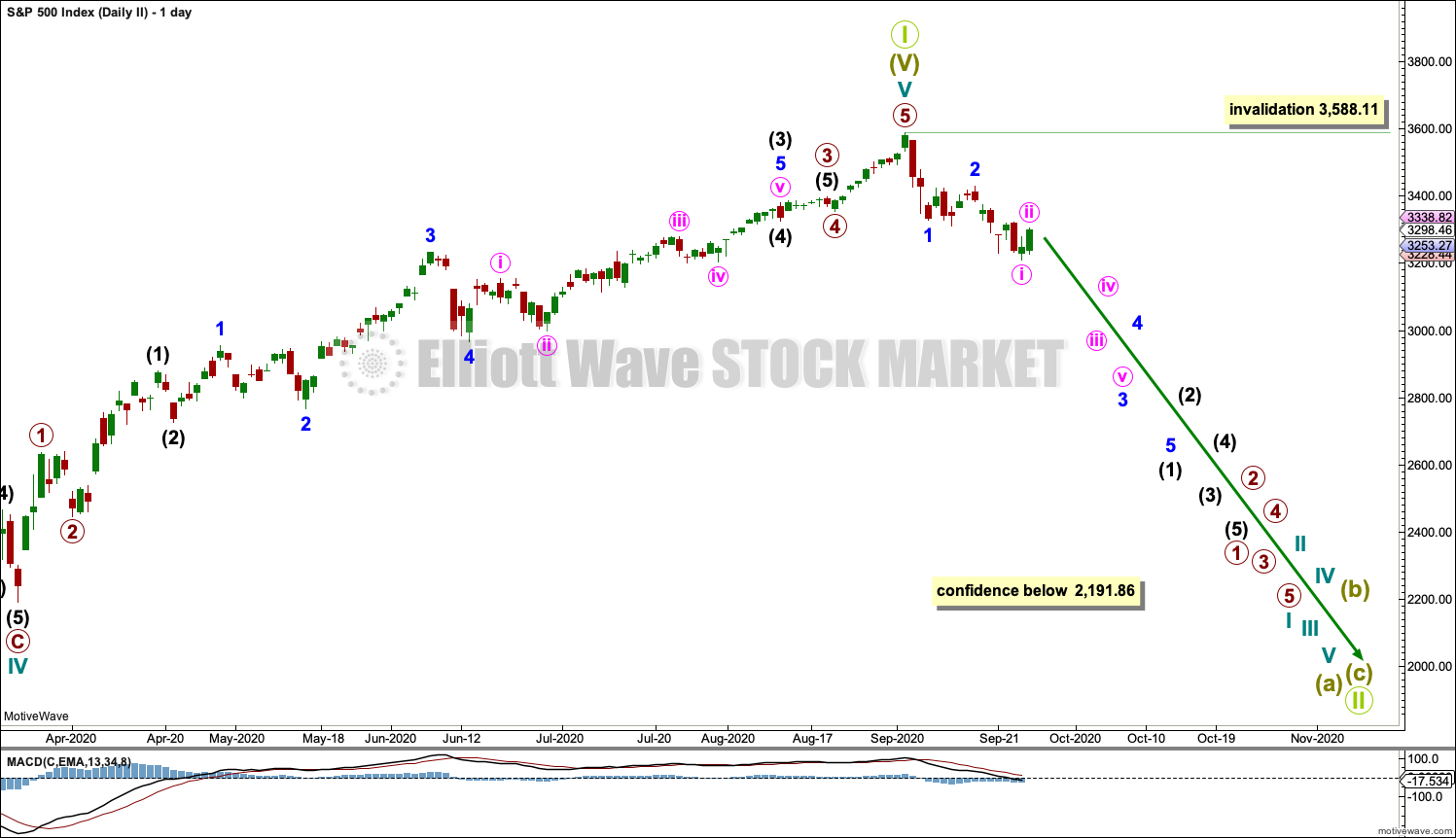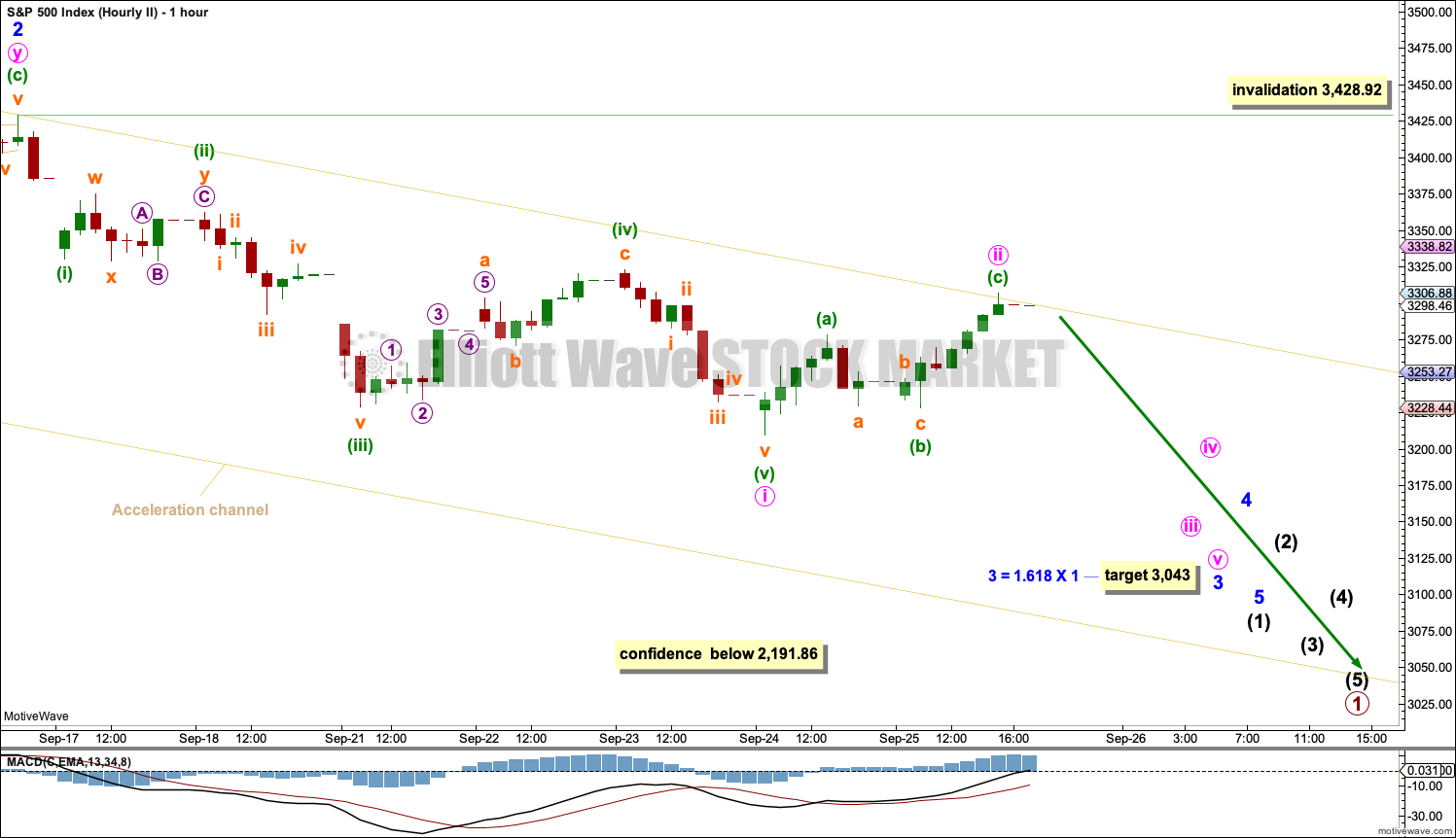S&P 500: Elliott Wave and Technical Analysis | Charts – September 25, 2020
Price remains below a short-term invalidation point. Upwards movement ended exactly at the upper edge of a channel.
Alternate Elliott wave counts are used to navigate price movement next week.
Summary: The first wave count expects that a pullback or consolidation may continue next week. It may find support about 3,055 (most likely) or 2,725.
For the short term, a new high now above 3,428.92 would indicate the pullback may be over.
The second wave count considers the possibility that a once in multi-generations trend change may have occurred. Some confidence in this wave count would come with invalidation of the first wave count below 2,191.86.
At this stage, a new high above 3,330.30 would be bullish.
The biggest picture, Grand Super Cycle analysis, is here.
Monthly charts are here, with video here.
ELLIOTT WAVE COUNTS
FIRST WAVE COUNT
WEEKLY CHART
Cycle wave V may last from one to several years. So far it has lasted 6 months.
Cycle wave V would most likely subdivide as an impulse. But if overlapping develops, then an ending diagonal should be considered. This chart considers the more common impulse.
Primary wave 1 may be complete. Primary wave 2 may not move beyond the start of primary wave 1 below 2,191.86.
There is already a Fibonacci ratio between cycle waves I and III within Super Cycle wave (V). The S&P500 often exhibits a Fibonacci ratio between two of its actionary waves but rarely between all three; it is less likely that cycle wave V would exhibit a Fibonacci ratio. The target for Super Cycle wave (V) to end would best be calculated at primary degree, but that cannot be done until all of primary waves 1, 2, 3 and 4 are complete. The target at 4,034 is provisional, so it may change.
DAILY CHART
Primary wave 1 may be over and primary wave 2 may have begun.
Primary wave 2 may be a multi-week pullback or consolidation. Primary wave 2 may not move beyond the start of primary wave 1 below 2,191.86.
For the S&P500, the first multi-week second wave correction within a new trend is not always very deep. Two examples from prior bull markets: after the bear market of October 1987, the first multi-week second wave in the following bull market ended in September 1990 and was only a 0.49 correction of its corresponding first wave, and more recently the last bull market beginning in March 2009 saw its first multi-week second wave correction end in June 2009, which was only a 0.30 correction of its corresponding first wave.
The 0.236 Fibonacci ratio of primary wave 1 at 3,258.59 has been passed. The next target is now the 0.382 Fibonacci ratio at 3,054.74. If price falls through that preferred target, then the 0.618 Fibonacci ratio at 2,725.23 would be the next target.
Primary wave 2 is labelled as a zigzag, which is the most likely structure to unfold. However, it may also unfold as a double zigzag, double combination or flat correction. Labelling within primary wave 2 may yet need to be changed.
If primary wave 2 is unfolding as a zigzag, then within it intermediate waves (A) and (B) may be complete. Intermediate wave (C) may continue lower next week as an impulse. Minor wave 2 within intermediate wave (C) may not move beyond the start of minor wave 1 above 3,428.92. A new high in the short term above 3,428.92 may indicate an end to primary wave 2. At that stage, technical analysis would look for bullish indications that a low may be in place.
A breach of the small channel drawn about primary wave 2 by a full daily candlestick above and not touching the upper edge would add confidence that primary wave 2 may be over.
HOURLY CHART
Intermediate wave (C) must subdivide as a five wave structure, most likely an impulse. Minor wave 1 may be complete at the last low.
Minor wave 2 may not move beyond the start of minor wave 1 above 3,428.92.
Minor wave 2 may be complete at the high on Friday, finding resistance at the upper edge of the Elliott channel.
ALTERNATE HOURLY CHART
It is possible that intermediate wave (C) may be complete by simply moving the degree of labelling within it up one degree.
This wave count requires a breach of the channel and a new high above 3,428.92 for confidence.
It also requires some support from technical analysis in bullish signals and indication that strength from buyers has returned.
It would also be possible to move the degree of labelling within primary wave 2 down one degree and see only a first zigzag in a possible double zigzag complete at the last low. It is for this reason that technical analysis would be required to support this wave count.
SECOND WAVE COUNT
DAILY CHART
This wave count is the same as the first wave count with the exception of the degree of labelling within cycle wave V. If the degree of labelling is moved up one degree, then it is possible that cycle wave V to end Super cycle wave (V) to end Grand Super Cycle wave I is complete.
A new low below 2,191.86 would add confidence in this wave count. At that stage, the first wave count would be invalidated.
A new bear market at Grand Super Cycle degree may be expected to last over a decade. It may take price below the start of Super Cycle wave (V) at 666.79 in March 2009.
HOURLY CHART
It is possible that a Grand Super Cycle degree trend change may have occurred.
The first five down within the new trend is labelled minor wave 1 (it is now off to the left of the chart).
Minor wave 2 may be complete.
Minor wave 3 may have begun. Minor wave 3 may only subdivide as an impulse. Minute wave i within minor wave 3 may be complete. Minute wave ii may not move beyond the start of minute wave i above 3,428.92.
Add an acceleration channel, which is drawn in the same way as the Elliott channel on the first hourly chart. Any stronger bounces along the way down may find resistance at the upper edge of the channel. The power of minor wave 3 should break below support of the lower edge of the channel.
When intermediate wave (1) may be complete, then the invalidation point would have to move back up to its start. Intermediate wave (2) should be a bounce to last at least a week or two, and it may not move beyond the start of intermediate wave (1) above 3,588.11.
TECHNICAL ANALYSIS
WEEKLY CHART
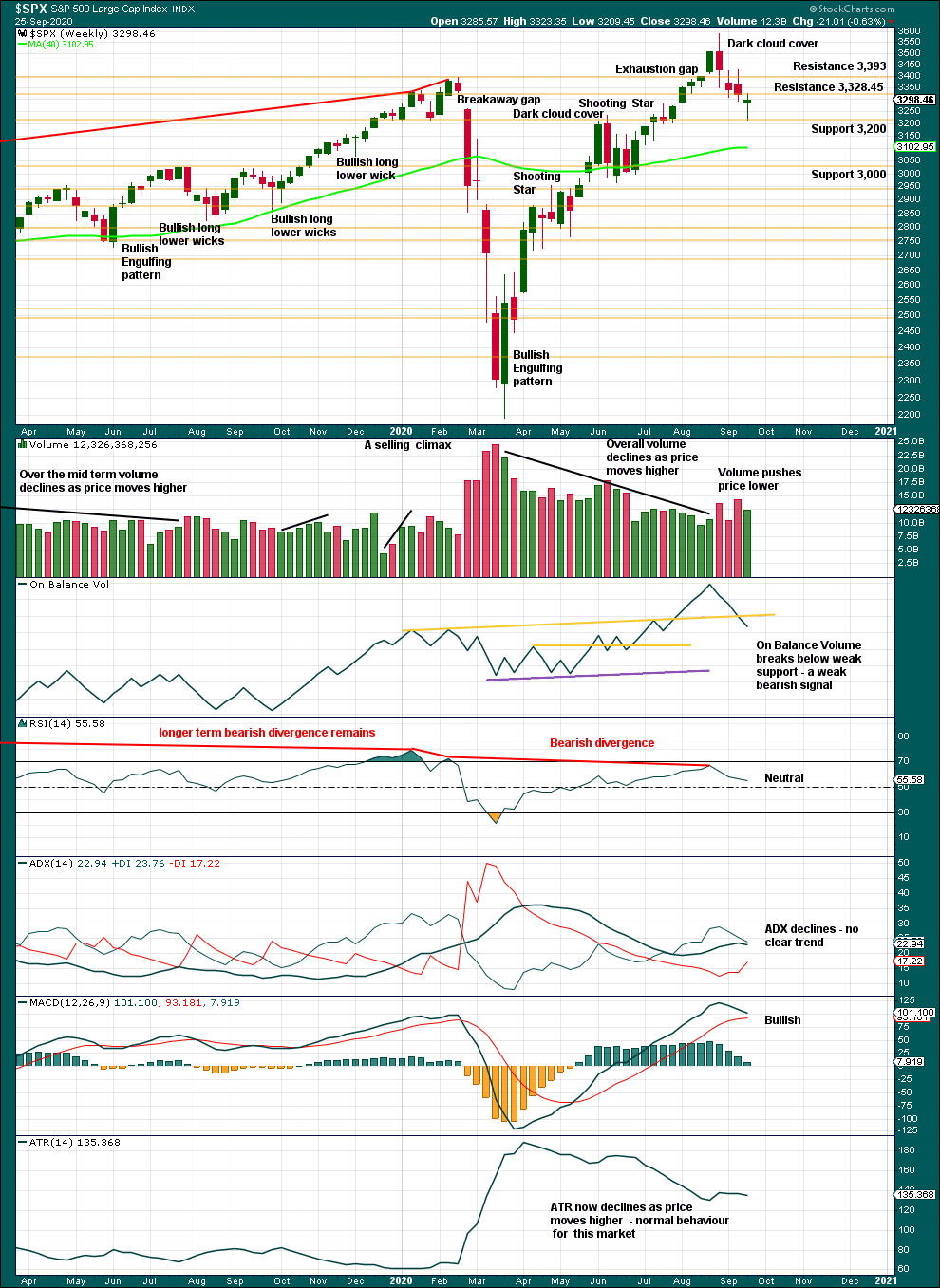
Click chart to enlarge. Chart courtesy of StockCharts.com.
A doji this week represents a pause and is not on its own a reversal pattern. Doji in down trends do not hold as much significance as when they occur in up trends.
This week the bearish signal from On Balance Volume supports the view that price may continue to fall next week.
DAILY CHART
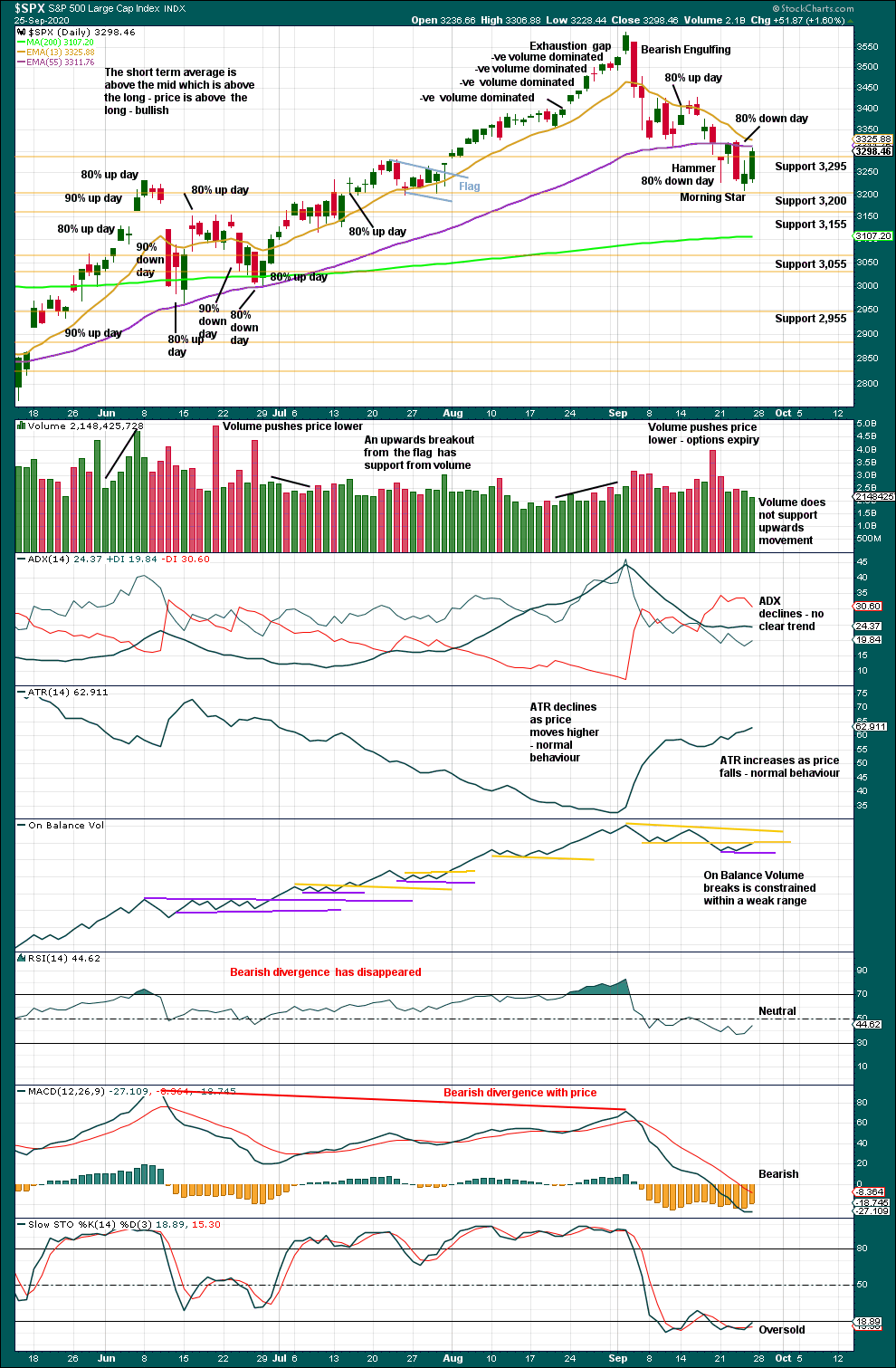
Click chart to enlarge. Chart courtesy of StockCharts.com.
Selling normally intensifies near lows. Two 80% down days (both near 90% down days but not quite) within the last five sessions suggests selling is intensifying. With Stochastics oversold and price bouncing up off support about 3,200, it is possible that a low may be in place here.
However, the return of strength in buying is absent. Although Friday saw a strong green candlestick to complete a Morning Star pattern, it lacks support from volume which significantly weakens the reversal pattern.
If one 90% upwards day or two back to back 80% upwards days complete next week, then confidence that a low is in place may be had. That has not happened yet, so it may be wisest to expect the pullback to continue lower.
BREADTH – AD LINE
WEEKLY CHART
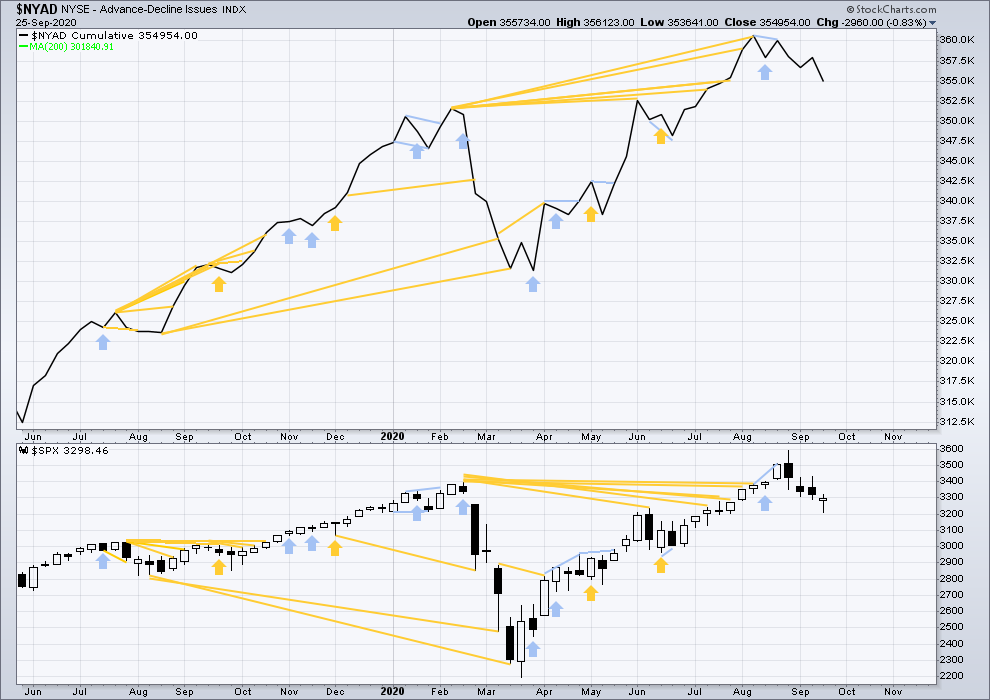
Click chart to enlarge. Chart courtesy of StockCharts.com. So that colour blind members are included, bearish signals will be noted with blue and bullish signals with yellow.
Breadth should be read as a leading indicator.
Lowry’s Operating Companies Only AD line has still not made new all time highs. The last high for the OCO AD line was in the week beginning January 13, 2020. There was 7 and a half months of bearish divergence between price and the OCO AD line at the September high. This may now support the more bearish second wave count. It is possible now that a major trend change may have ocurred.
The NYSE All Issues AD line made new highs in the week beginning 1st of June.
This week both price and the AD line have declined. There is no new divergence.
Large caps all time high: 3,588.11 on September 2, 2020.
Mid caps all time high: 2,109.43 on February 20, 2020.
Small caps all time high: 1,100.58 on August 27, 2018.
This rise has been led by large caps, which is a feature of an aged bull market. Only large caps have made new highs above the last swing high of the 11th of August.
DAILY CHART

Click chart to enlarge. Chart courtesy of StockCharts.com. So that colour blind members are included, bearish signals will be noted with blue and bullish signals with yellow.
Bullish divergence noted in last analysis has been followed by some upwards movement, so it may be resolved.
On Friday both price and the AD line have moved higher. There is no new divergence.
VOLATILITY – INVERTED VIX CHART
WEEKLY CHART
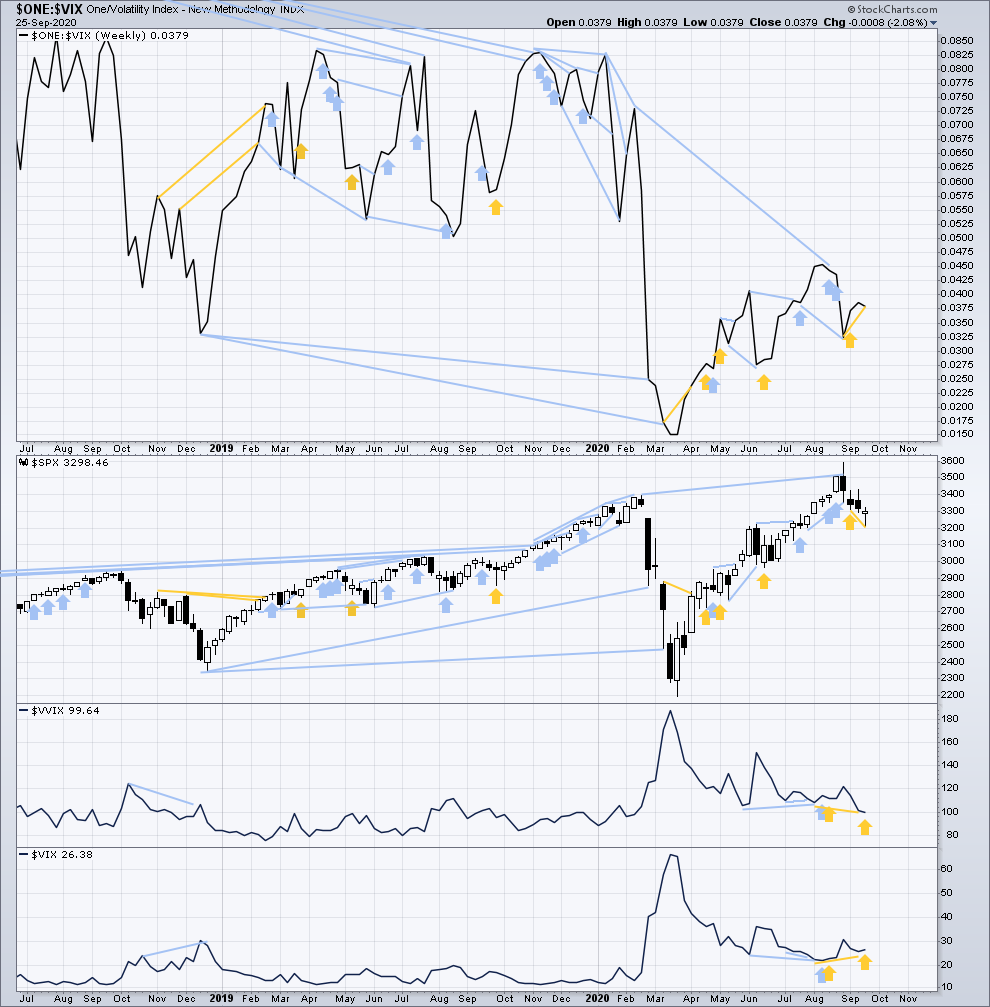
Click chart to enlarge. Chart courtesy of StockCharts.com. So that colour blind members are included, bearish signals will be noted with blue and bullish signals with yellow.
Inverted VIX remains well below all time highs. The all time high for inverted VIX was in the week beginning October 30, 2017. There is nearly 3 years of bearish divergence between price and inverted VIX. There is all of long, mid and short-term bearish divergence.
This week price has moved lower to make a new short-term low below the low of two weeks prior, but inverted VIX has not made a corresponding new low. This divergence is bullish for the short term.
Comparing VIX and VVIX: This week VIX has increased, but VVIX has declined. This divergence is bullish for price in the very short term.
DAILY CHART
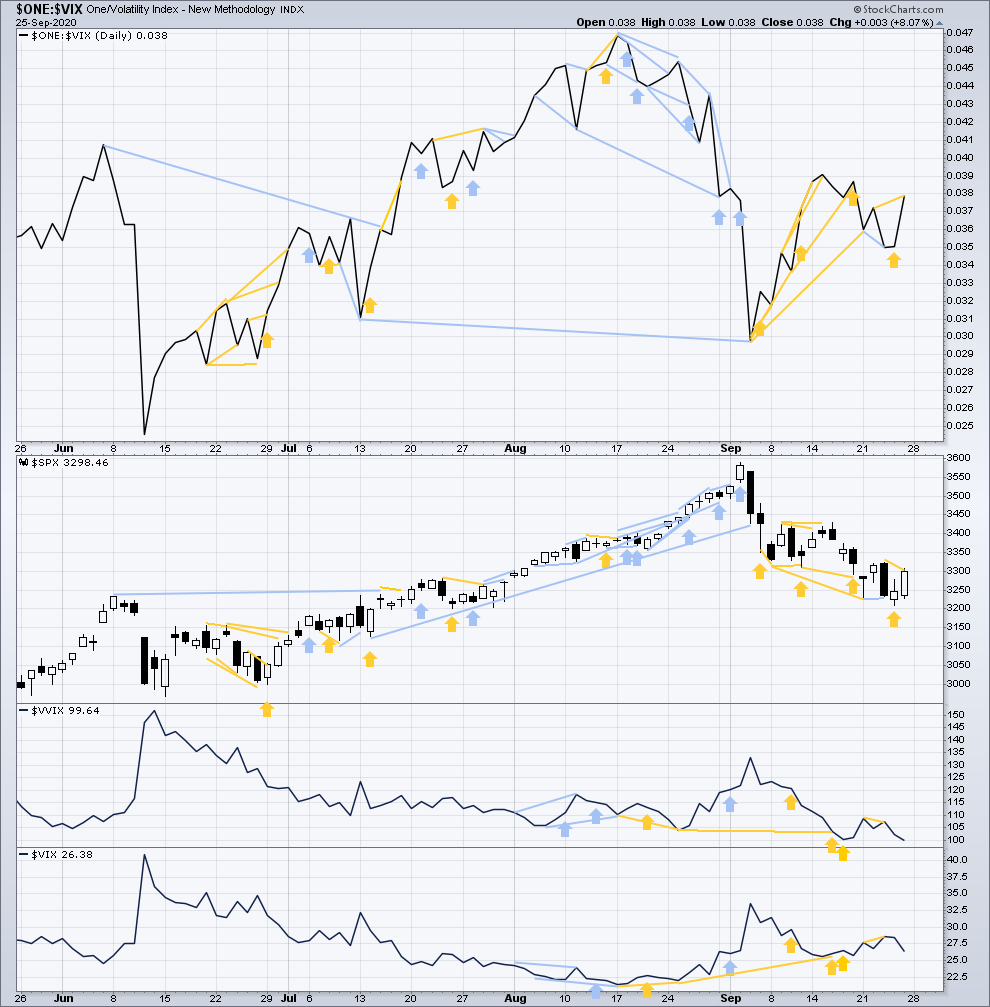
Click chart to enlarge. Chart courtesy of StockCharts.com. So that colour blind members are included, bearish signals will be noted with blue and bullish signals with yellow.
Bullish divergence noted in last analysis has been followed by upwards movement, so it may be resolved.
On Friday inverted VIX made a new short-term swing high, but price has not. This divergence is bullish for the short term.
Inverted VIX remains well above lows of the 3rd to 8th of September, but price is below. This divergence remains bullish.
Comparing VIX and VVIX at the daily chart level: VVIX is declining faster than VIX for the short term. This is bullish for price in the short term.
DOW THEORY
Dow Theory still concludes a bear market is in place.
Dow Theory confirmed a bear market with the following lows made on a closing basis:
DJIA: 21,712.53 – a close below this point was been made on the March 12, 2020.
DJT: 8,636.79 – a close below this point was been made on March 9, 2020.
Adding in the S&P and Nasdaq for an extended Dow Theory, a bear market was confirmed:
S&P500: 2,346.58 – a close below this point was made on March 20, 2020.
Nasdaq: 7,292.22 – a close below this point was made on the March 12, 2020.
At this time, to shift Dow Theory from viewing a bear market to confirmation of a new bull market would require new highs made on a closing basis:
DJIA: 29,568.57
DJT: 11,623.58
Adding in the S&P and Nasdaq for an extended Dow Theory, confirmation of a bull market would require new highs made on a closing basis:
S&P500: 3,393.52 – closed above on 21st August 2020.
Nasdaq: 9,838.37 – closed above on June 8, 2020.
Published @ 08:53 p.m. ET.
—
Careful risk management protects your trading account(s).
Follow my two Golden Rules:
1. Always trade with stops.
2. Risk only 1-5% of equity on any one trade.
—
New updates to this analysis are in bold.

